EFL Football is back.
On the opening weekend of the 2023/24 season, many games were hit by horrible rainy conditions, with Colchester United’s tie against Swindon Town even being postponed.
It rained goals as well, with nine teams scoring three or more goals – Barnsley being the pick of that bunch thanks to their 7-0 win over Port Vale… sorry Vale fans!
The EFL Championship kicked off a day before the rest of the EFL as we saw two teams who are returning to the division face off in Sheffield Wednesday and Southampton.
One of the Saints’ fellow relegated sides, Leicester City, started life back in the division with three points.
The Foxes have Kiernan Dewsbury-Hall to thank for this, as the midfielder netted both goals to bring his side from 1-0 down to win 2-1 against Coventry City.
This Leicester tactical analysis will provide an insight into the tactics of Leicester – how they approached things on and off the ball.
We will also take a look at how Coventry City FC approached their possession.
There will also be an analysis of Dewsbury-Hall’s increased impact in the latter stages of the game, as he was a key figure for Enzo Maresca.
Lineups
Hosts Leicester kicked off the Maresca era with a 4-3-3, with five debutants starting.
One of them was in goal – Mads Hermansen joined over the summer from Danish club Bröndby IF, and at just 23, he could be Leicester’s man between the sticks for years to come.
Callum Doyle, another new signing, featured at left-back after joining on loan from Premier League champions Manchester City.
Ricardo Pereira started at right-back on the opposite side of the back four.
The experienced Janik Vestergaard was joined by Wout Faes in the heart of Leicester’s defence.
Harry Winks was debutant number three, coming to make an extremely talented midfield trio with Dewsbury-Hall and Wilfred Ndidi.
While there was fluidity in terms of positions in the midfield, Winks was naturally the deeper of the three, allowing Dewsbury-Hall to have an attacking influence.
At the same time, Ndidi looked to be the aggressor in higher areas off the ball.
The front three featured a fourth debutant in Stephy Mavididi – the Englishman, who joined from French club Montpellier, played on the left wing, with a fifth debutant in academy product Kasey McAteer.
Premier League icon Jamie Vardy led the line.
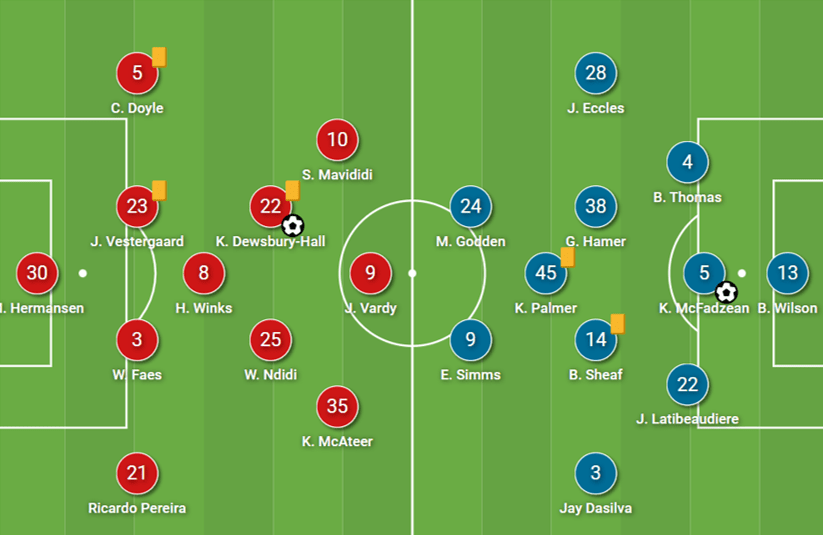
2022/23 play-off finalists Coventry deployed a 3-5-2, with four starting debutants – plus another three from the bench.
Boss Mark Robins opted for Ben Wilson, with the back three ahead of him containing two of the new boys.
Veteran Kyle McFadzean had debutants on either side of him in Bobby Thomas and Joel Latibeaudiere, joining from Burnley and Swansea, respectively.
Josh Eccles and Jay Dasilva (another new signing) occupied the wing-back roles, offering support to the midfield in possession when possible.
There were no new faces in the engine room, with Ben Shead and Gustavo Hamer joining Kasey Palmer.
Up front, Matty Godden was joined by new signing Ellis Simms, who joins from Everton following plenty of Championship interest.
Possession isn’t always everything – an insight into the tactics of both sides.
If you missed the game but happened to check the match stats, you may initially think that Leicester dominated proceedings with their 65% possession and 642 passes – almost double Coventry’s amount.
While the Foxes did control the game at times, it was not the typical display you see from a team with a possession total like that, in that the game was very open, very end-to-end, with both sides registering plenty of efforts on goal.

The xG map shows us that there wasn’t much between the two sides in an attacking sense – painting a different picture to the aforementioned possession stats.
Perhaps unsurprisingly, though, the hosts offered a higher threat overall, with more shots on target inside the box.
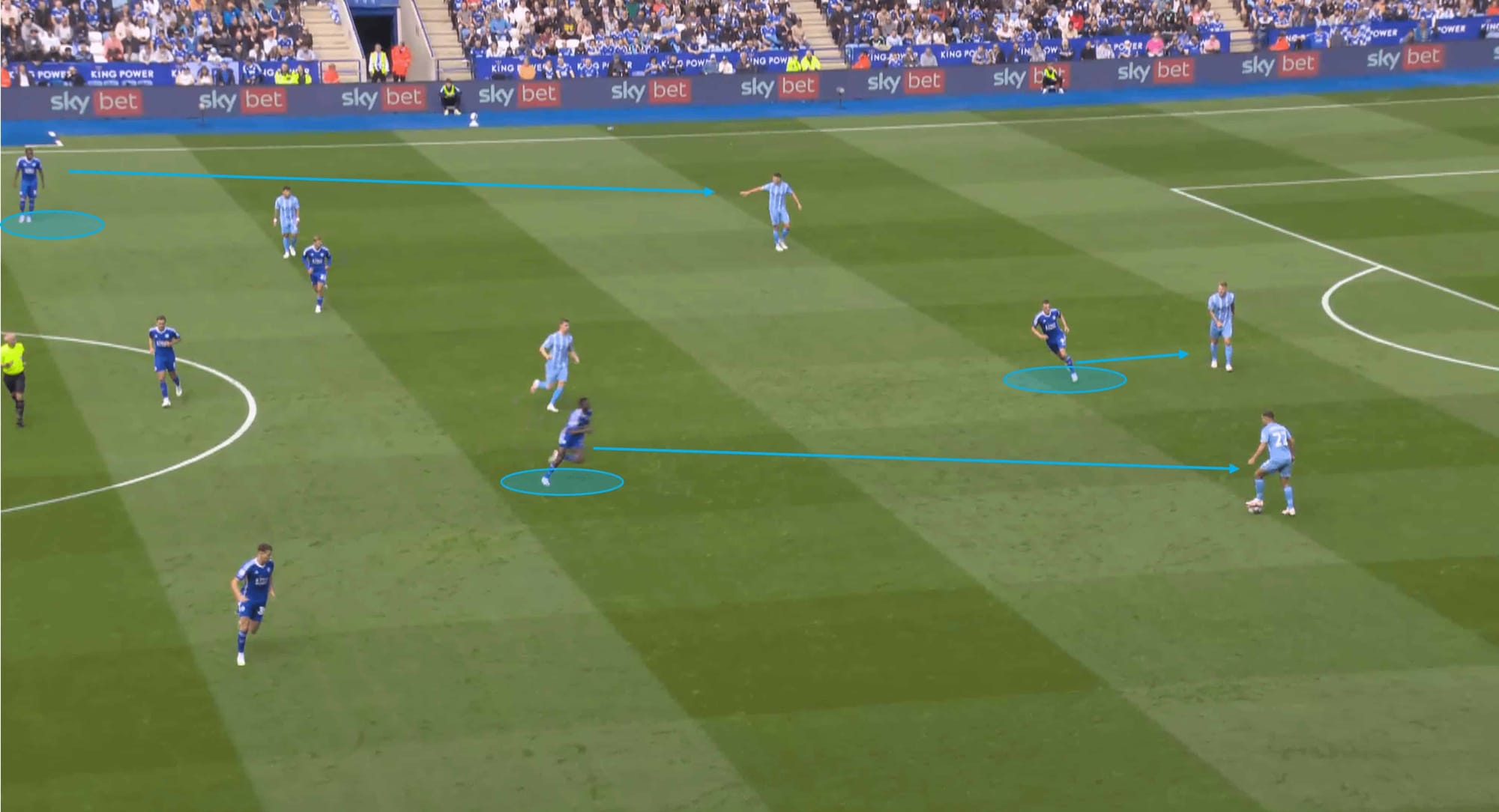
Disclaimer: Leicester didn’t put on a high-press masterclass, but their performance did incorporate high-pressing elements from time to time.
In fact, their tactics off the ball varied somewhat – they would look to press Coventry in higher areas like you see above, with Vardy operating centrally and the two wingers applying pressure to the full-backs on their side.
More often than not, though, it was a one-on-one type of press rather than the whole team/unit squeezing Coventry – we may see this come into play from Leicester as they continue to adjust to the Championship.
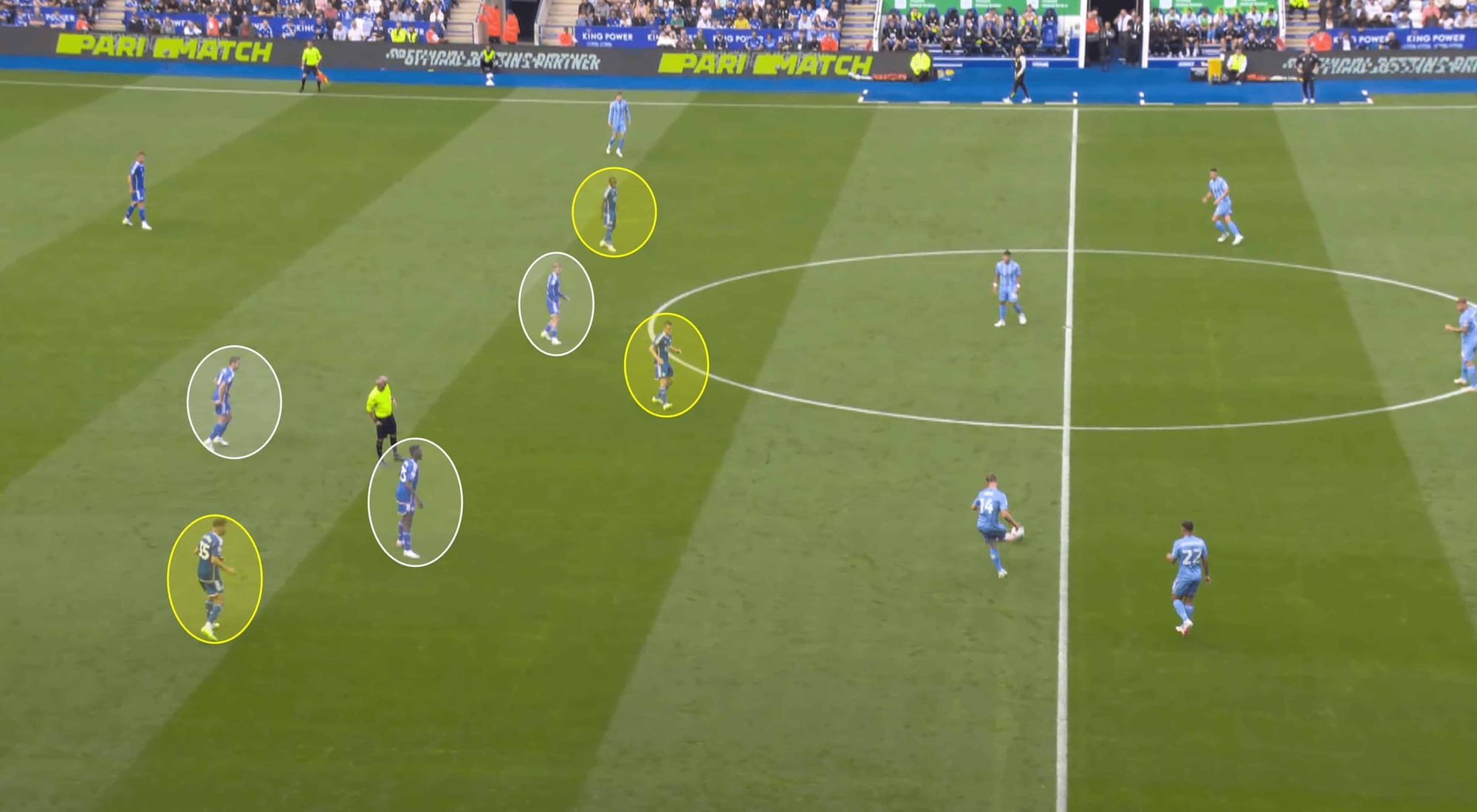
If the initial high press wasn’t an ideal option, Leicester were happy to regroup and allow Coventry some time on the ball – again, Vardy would press eventually in central areas.
In terms of shape, you may think Leicester’s set-up looks a little unorganised, as you’d expect from a typical mid-block, but Coventry rarely had a high attacking presence, especially in central areas.
We’d often see Leicester’s midfield trio tucked narrowly inside, with the front three forming a shell around them, with the wingers becoming more narrow to block the centre off even more.
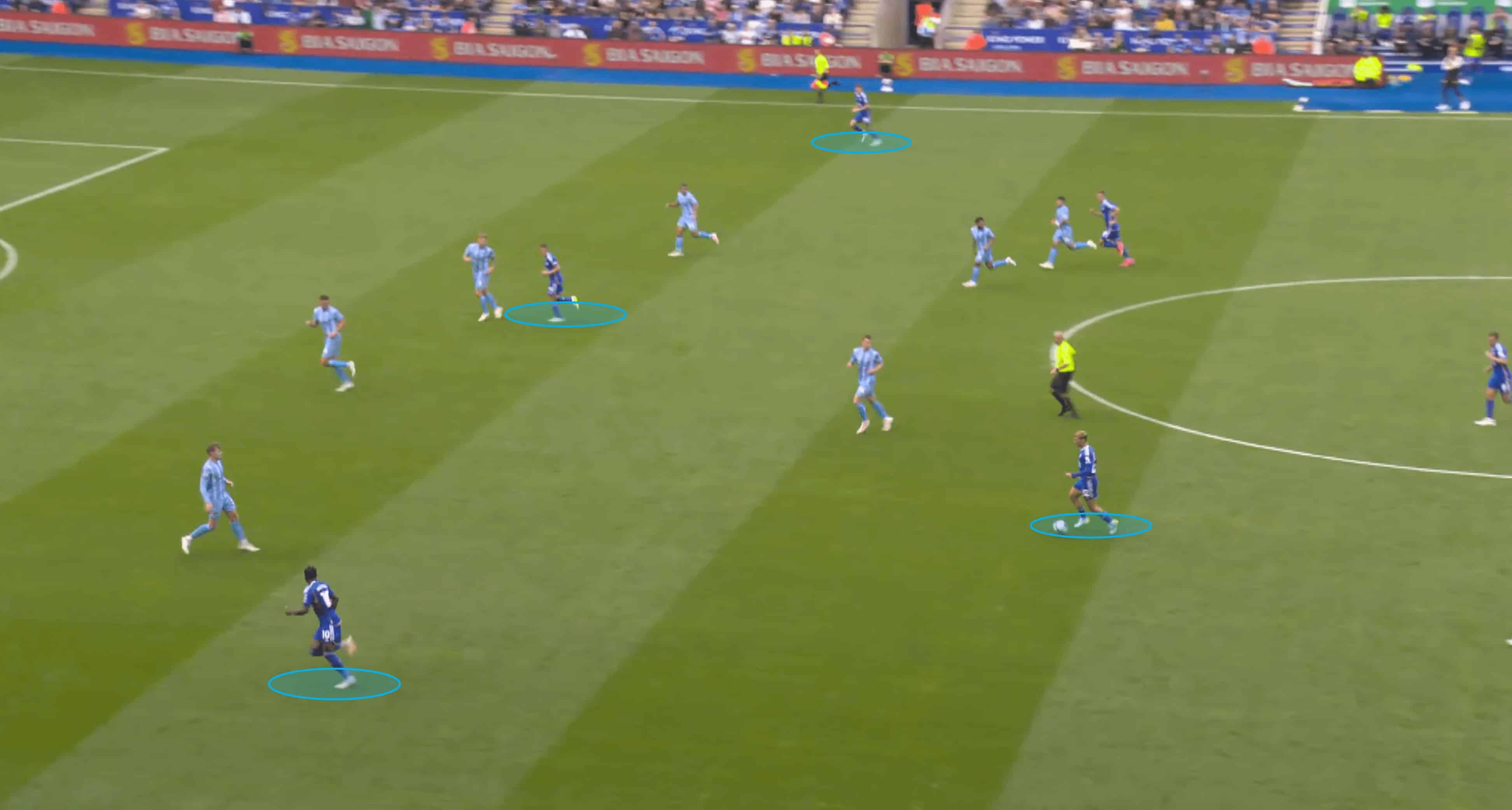
Width was important for the home side when building an attack.
But, similar to other areas of their system, their use of wide space was varied.
On the day, they had a very technical player on the left flank in Mavididi, and if we’re being fair, Leicester could’ve done with getting him more involved in 1v1 situations against Coventry’s right wing-back.
He did have a couple of instances that match this description, but many of Leicester’s play involved audacious passes into space that weren’t realistic regarding Mavididi and McAteer getting on the end of them.
Another noteworthy part of the Foxes’ tactics was utilising central areas, which we will cover later in the analysis.
But it is important to note that the midfield had the licence to drive forward with the ball as there was often the space to do so, something Dewsbury-Hall was very effective at.
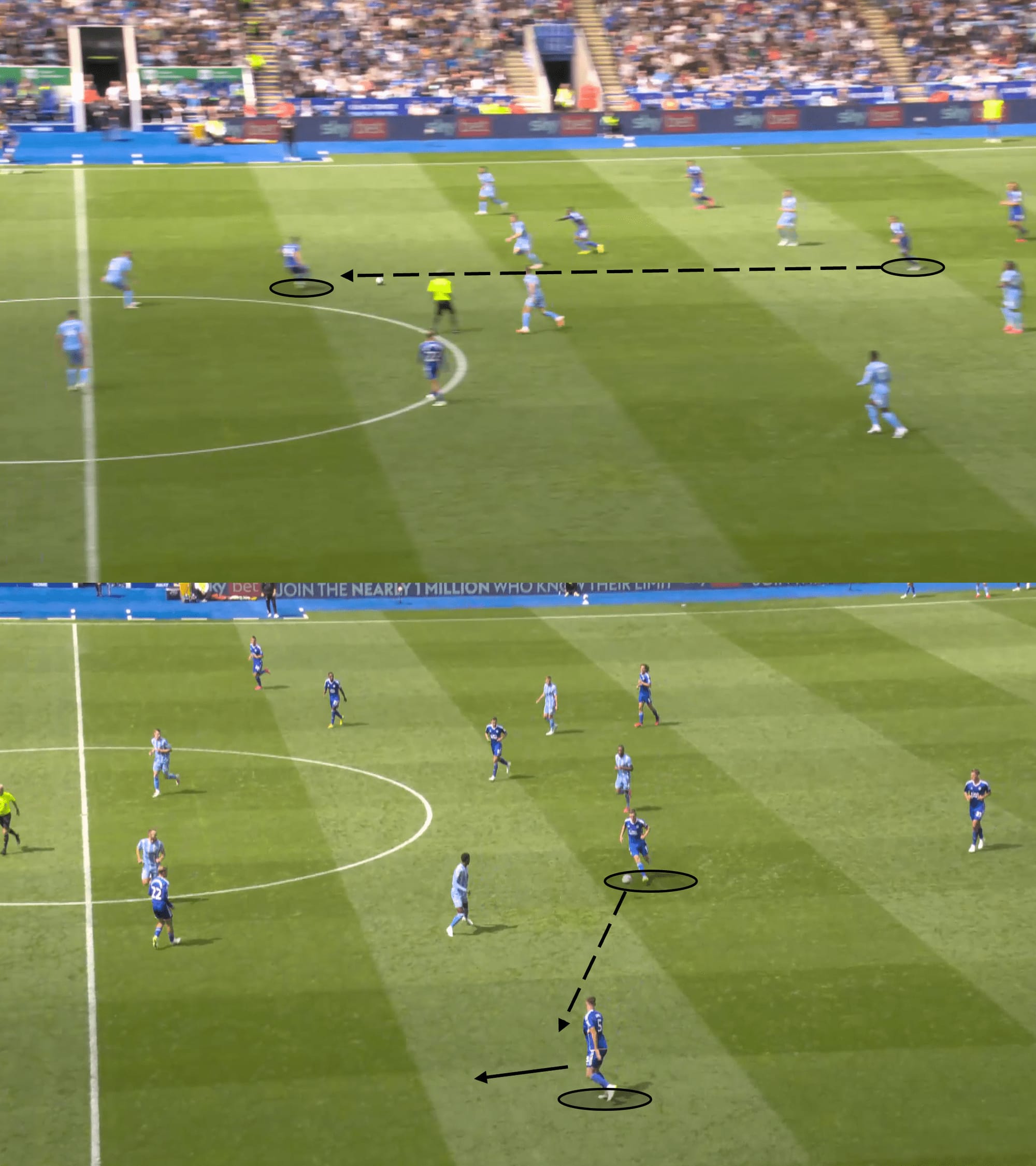
As we mentioned, Leicester found some success in playing through the centre in deeper areas of the pitch.
In particular, they were effective in playing line-breaking passes through Coventry shirts in midfield – this pass would cause a reaction from Coventry where the midfield unit would rush back to try and make up for being carved open.
This move also drew pressure into central areas, creating space out wide, which looked intentional from Leicester as they would often draw Coventry inside before playing out to the flanks, just like you see in the image above.

Moving on to analysing Coventry’s tactics in attack, we will soon start to understand how they were so active in the final third despite their low possession.
We mentioned earlier how Leicester weren’t using constant high pressure, which in turn saw Coventry being able to play and defend at the depth of their choosing – they weren’t forced into parking the bus all the time.
But they did have bodies back most of the time, which impacted their attacking play, seeing them play with a directness that had real potential to hurt Leicester.
Take the example above.
Hamer displays exceptional vision to pick out Palmer in the middle of the pitch, quickly turning risky possession inside Coventry’s half into an excellent attacking opportunity in Leicester’s half.
Palmer’s actions sustained the attacking tone set by Hamer’s pass, and really Leicester can count their lucky stars that they escaped this particular attack unscathed.
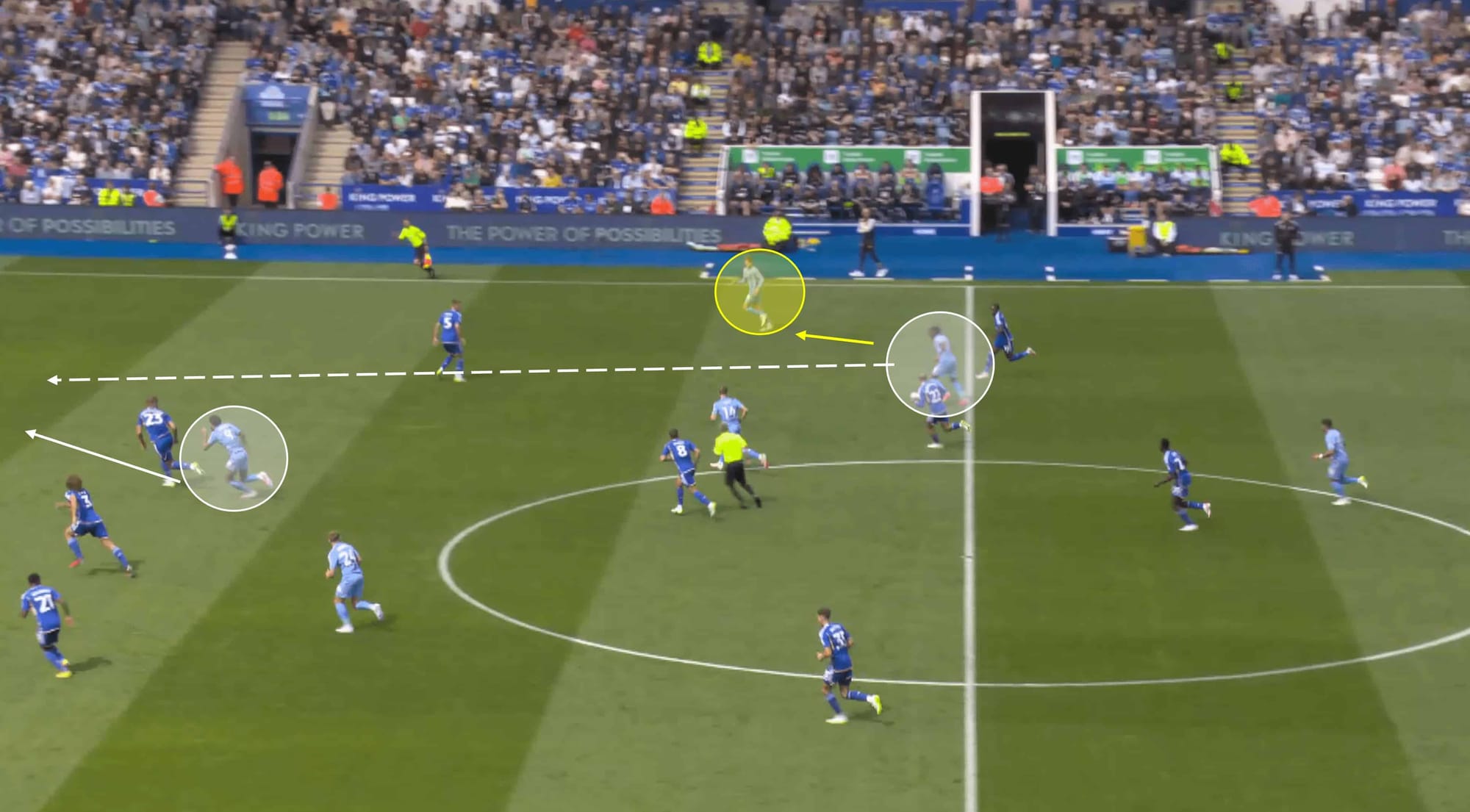
We see another example of the direct mindset in Coventry’s game plan here, but from a position where they had the opportunity to slow the game down to a pace that would allow for a controlled possession phase.
Instead, they looked to move the in behind the Leicester backline quickly, looking to outpace their opposition.
While the tactics here are clever from Robins’ side, tweaking small details could have changed the whole dynamic of this attack.
For example, the man on the ball, Palmer, had space ahead of him – he could’ve driven forward, forcing the Leicester left-back to come out to challenge him – this would’ve opened up space for the Coventry right-back to run into.
The fact that we saw these snap decisions to play direct passes in behind the Leicester backline suggests it was something Mark Robins really encouraged his men to attempt.
Dewsbury-Hall’s starring role in Foxes’ dramatic turnaround
The transfer window is still open, and if the rumours circulating on social media are to be believed, Dewsbury-Hall could make his Premier League return a lot sooner than his current club.
The midfielder has been the subject of transfer rumours, with Liverpool being one club linked with a move.
Of course, these are purely rumours at this point, so there is no reason for Leicester fans to panic just yet.
But somebody will come in for him if he continues to influence games like he did against Coventry.
Let’s look at how his attacking input allowed his side to take all three points on matchday one.
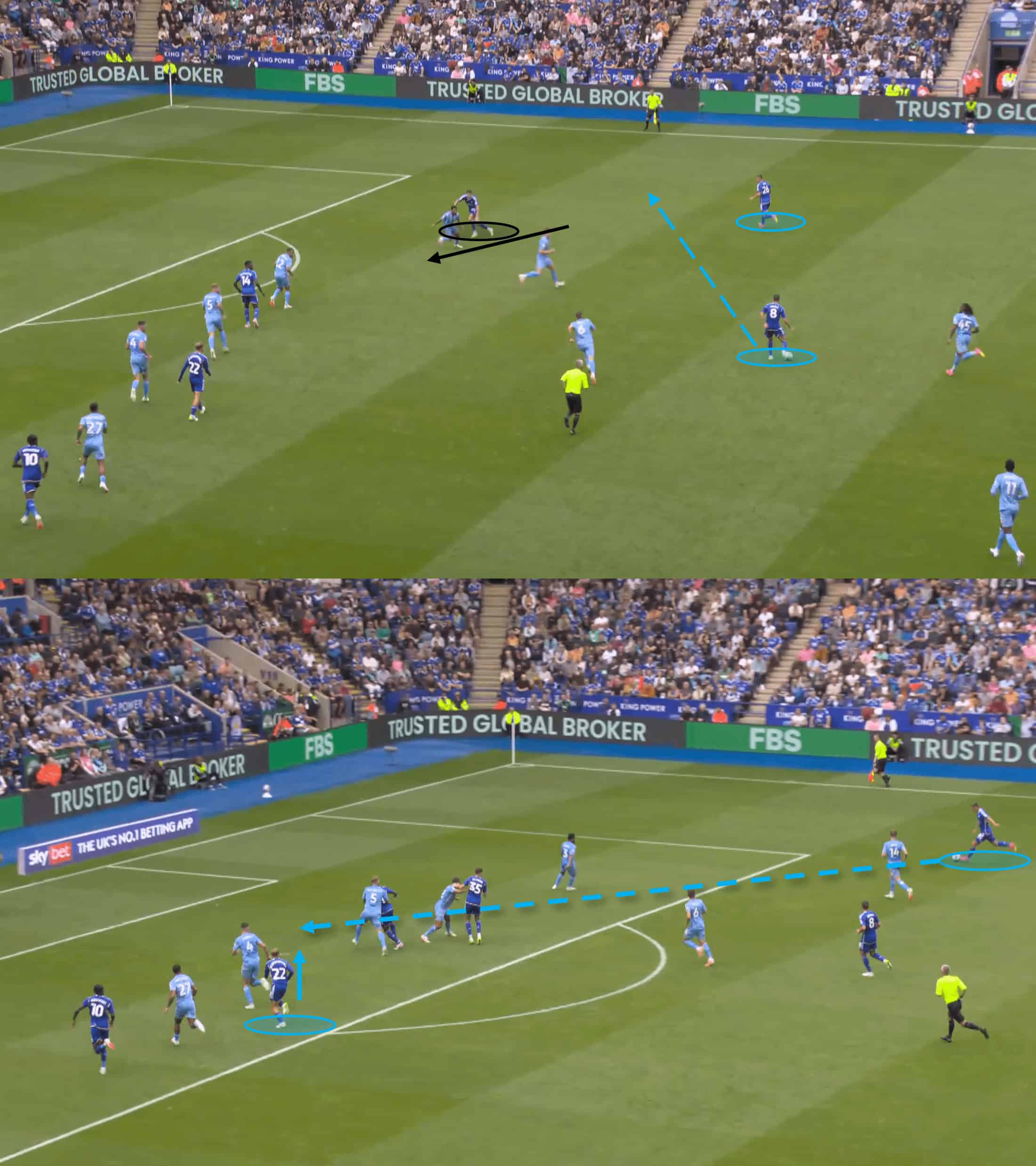
One of the most impressive things that were on display multiple times in this fixture was Dewsbury-Hall’s off-the-ball movement.
His ability to read situations and act accordingly and locate and utilise dangerous spaces unmarked by a sky-blue shirt made him talismanic in this match.
His presence in the box was increased later in the game as Leicester continued to search for a goal, and Dewsbury-Hall’s subtle yet vital movement to peel away from his marker to head in the incoming cross gave the Foxes an equaliser.
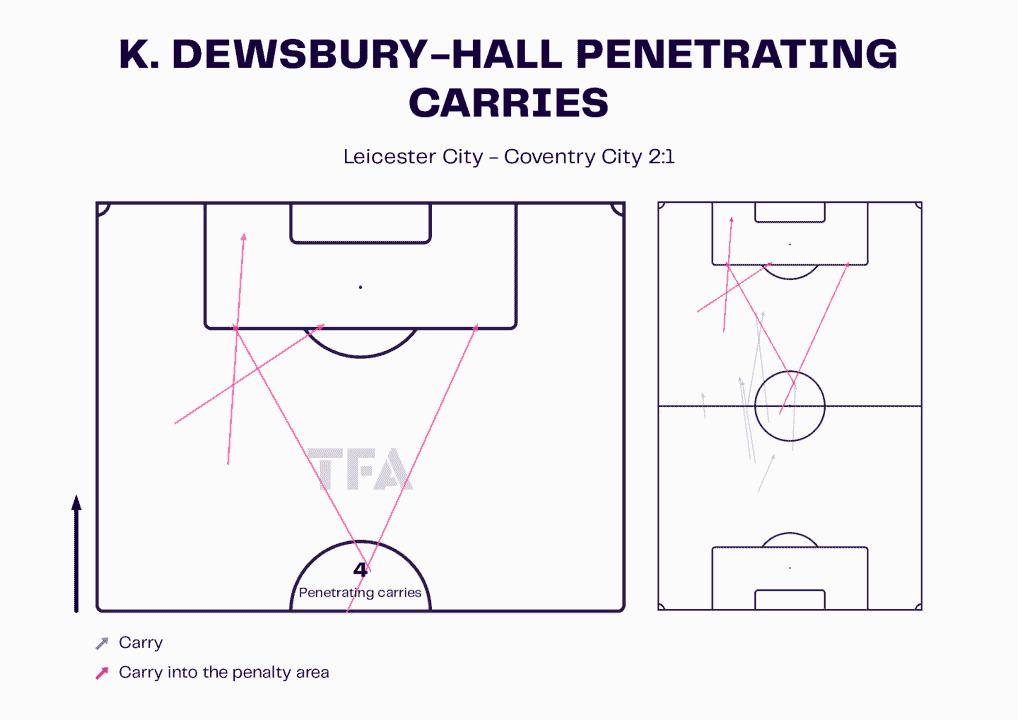
We’ll get back to the threat he poses in the box shortly, but it is only fair to highlight his ability on the ball in midfield areas, especially when carrying the ball in crucial areas.
We get a taste of that in the image above.
Dewsbury-Hall completed four penetrating carries on the day, showing a real ability to carry the ball into dangerous areas.
The right pitch image also indicates that he effectively carried the ball from Leicester’s half into Coventry’s half.
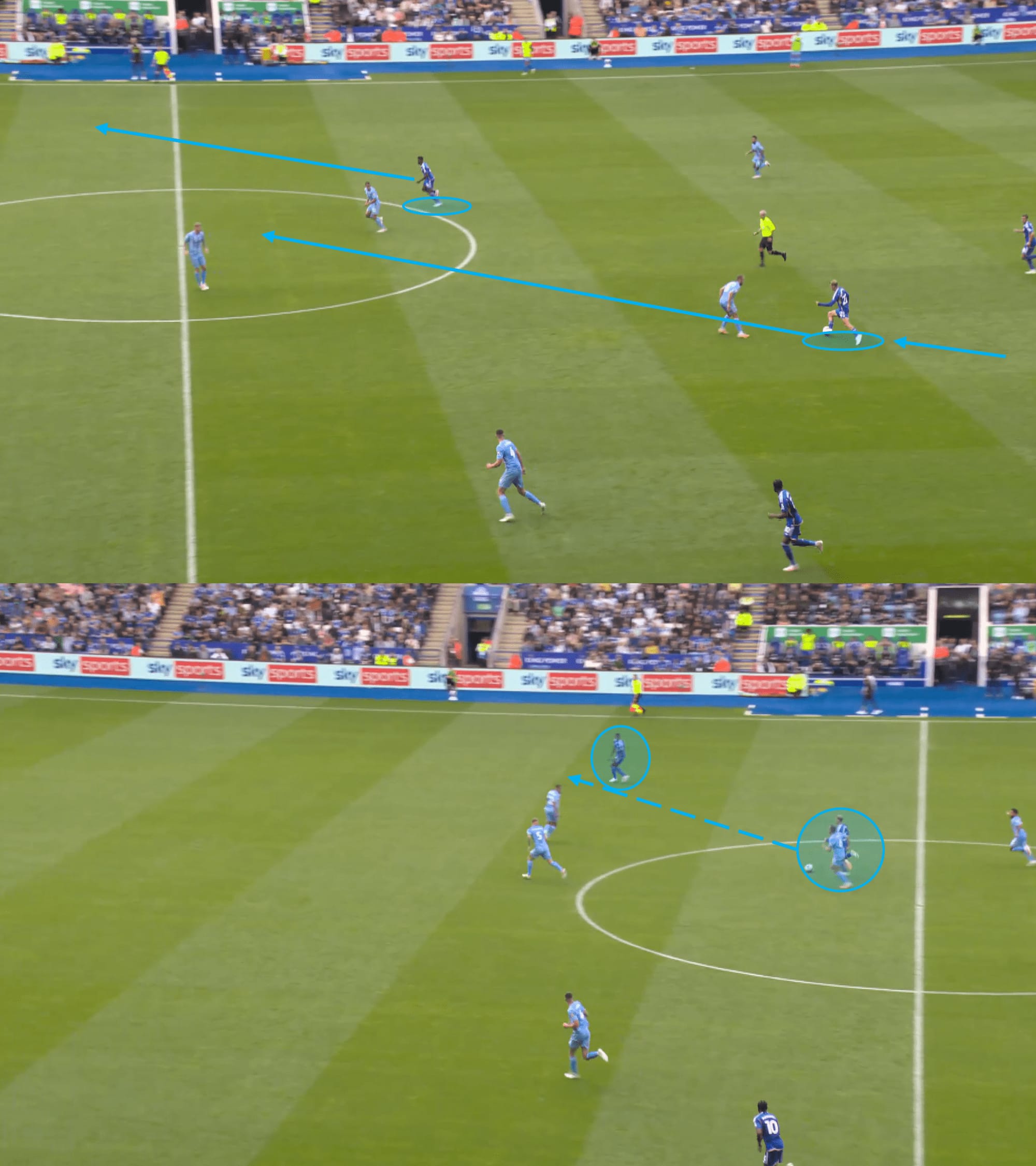
This example shows us just that – his ability to carry the ball out of Leicester’s half.
What you don’t see in the image above is that Dewsbury-Hall regained the ball from a Coventry shirt on the edge of Leicester’s box before striding forward with the ball.
He continued to eat up the yards, breezing through Coventry’s midfield before offloading the ball to the right flank.
He followed this action by continuing his run off the ball, offering good support in the final third.
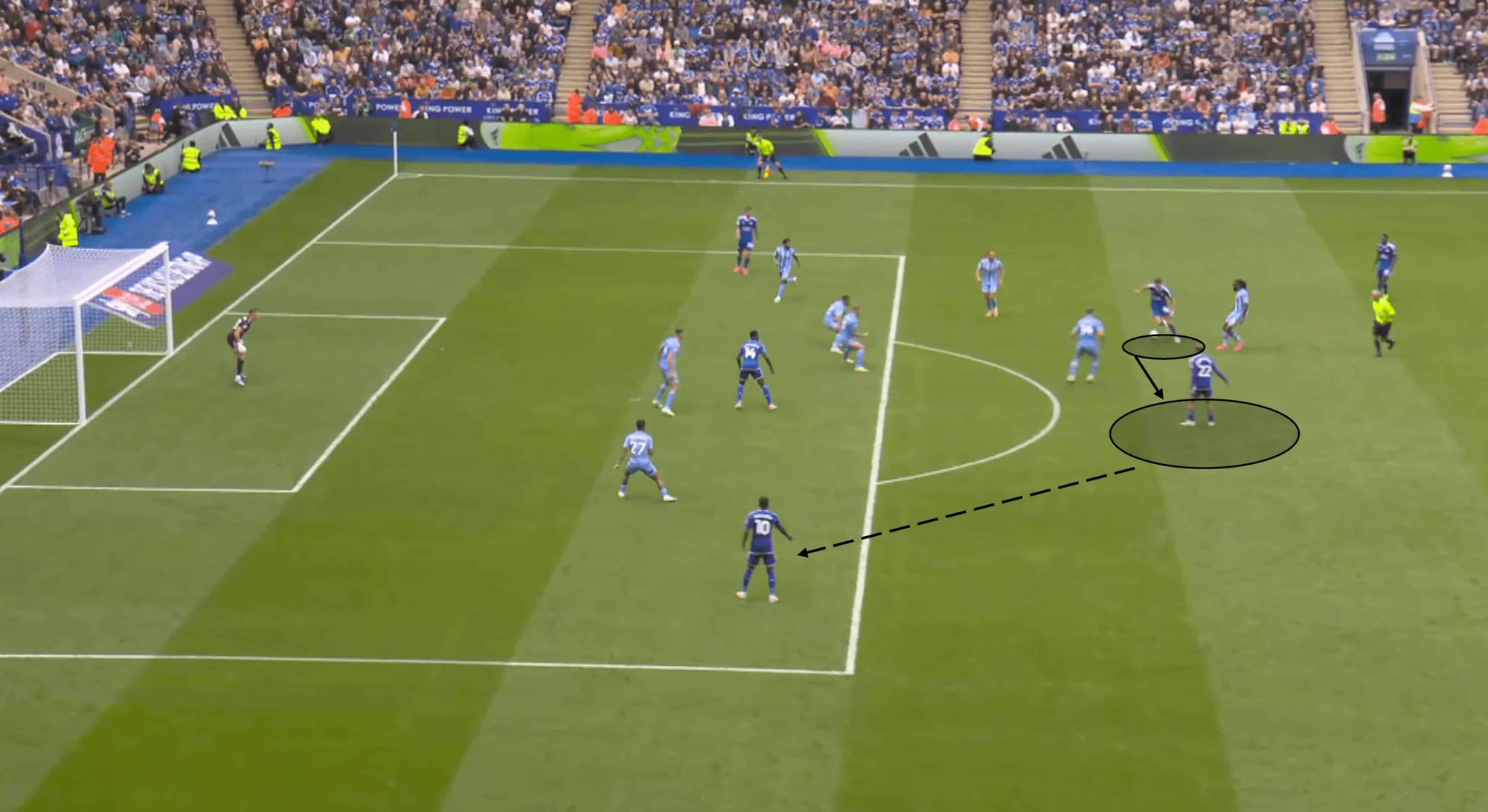
Time to break down his winning goal, with a spotlight being placed on his positioning and movement again.
Not only did he score the goal in this attack, but he was instrumental in its build-up too, getting himself into space about 25 yards from goal to receive the ball before moving the ball out to Mavididi on the left.
Just like the previous example, he followed his pass by offering a strong supporting position…
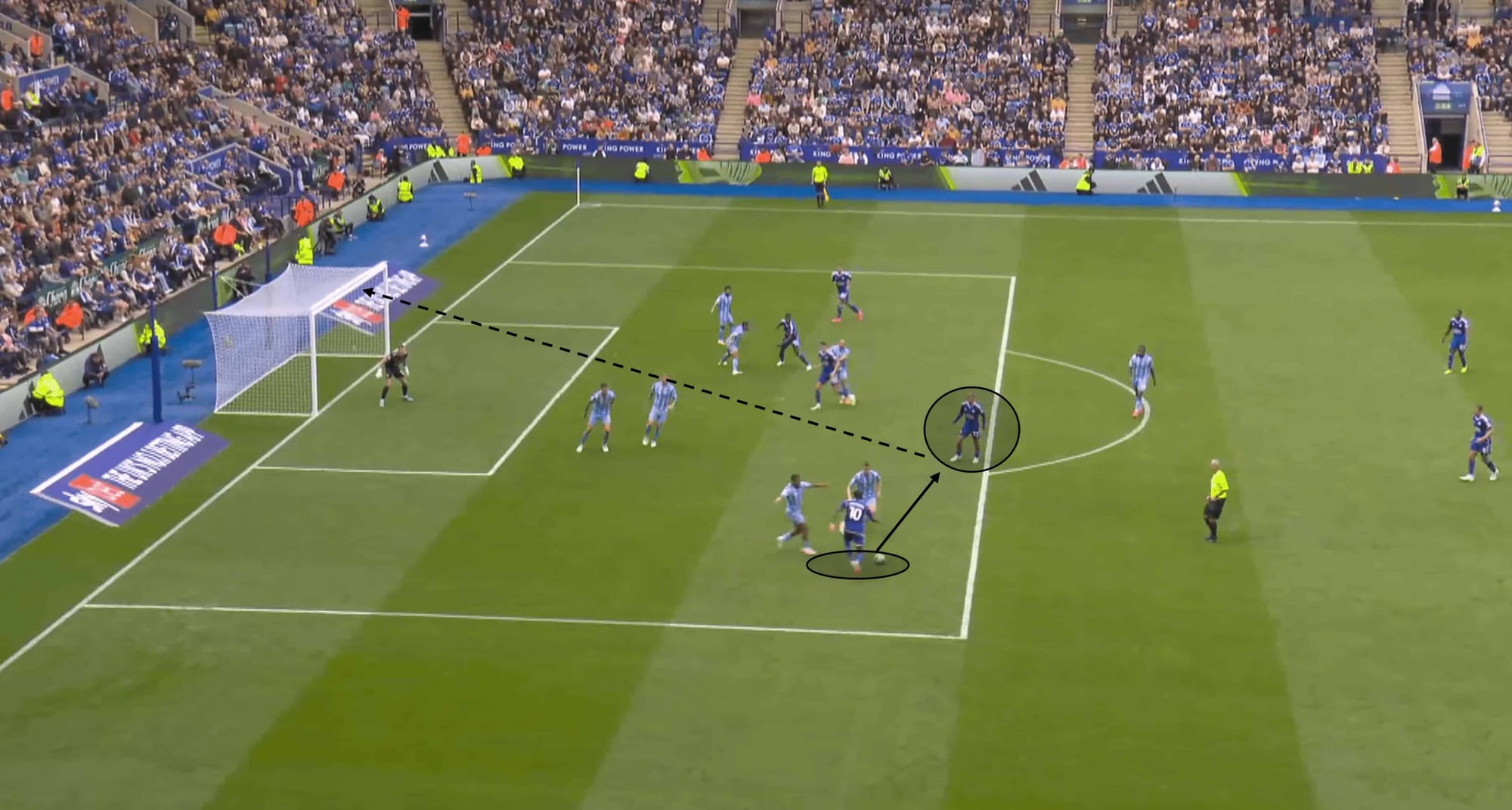
He knew his forward run would be enough to force Coventry players to follow him, but they didn’t stop to mark him when he placed himself at the edge of the box, instead continuing to add to Coventry’s defensive presence deeper in the box.
After some tricky footwork, Mavididi laid the ball off to Dewsbury-Hall in space, who ended the box by firing a rocket into the top corner.
Conclusion
Maresca will be delighted to open the season with a win, but areas of Leicester’s performance will concern him.
They allowed Coventry City far too many opportunities to attack, especially in transitions.
They certainly have the quality on paper to finish in the top two this season, but they will need to fine-tune their tactics to secure an immediate return to the Premier League.
Of course, Coventry will be disappointed to lose, but they will take plenty of positives from this fixture – expect them to be challenging around the play-offs again this season.

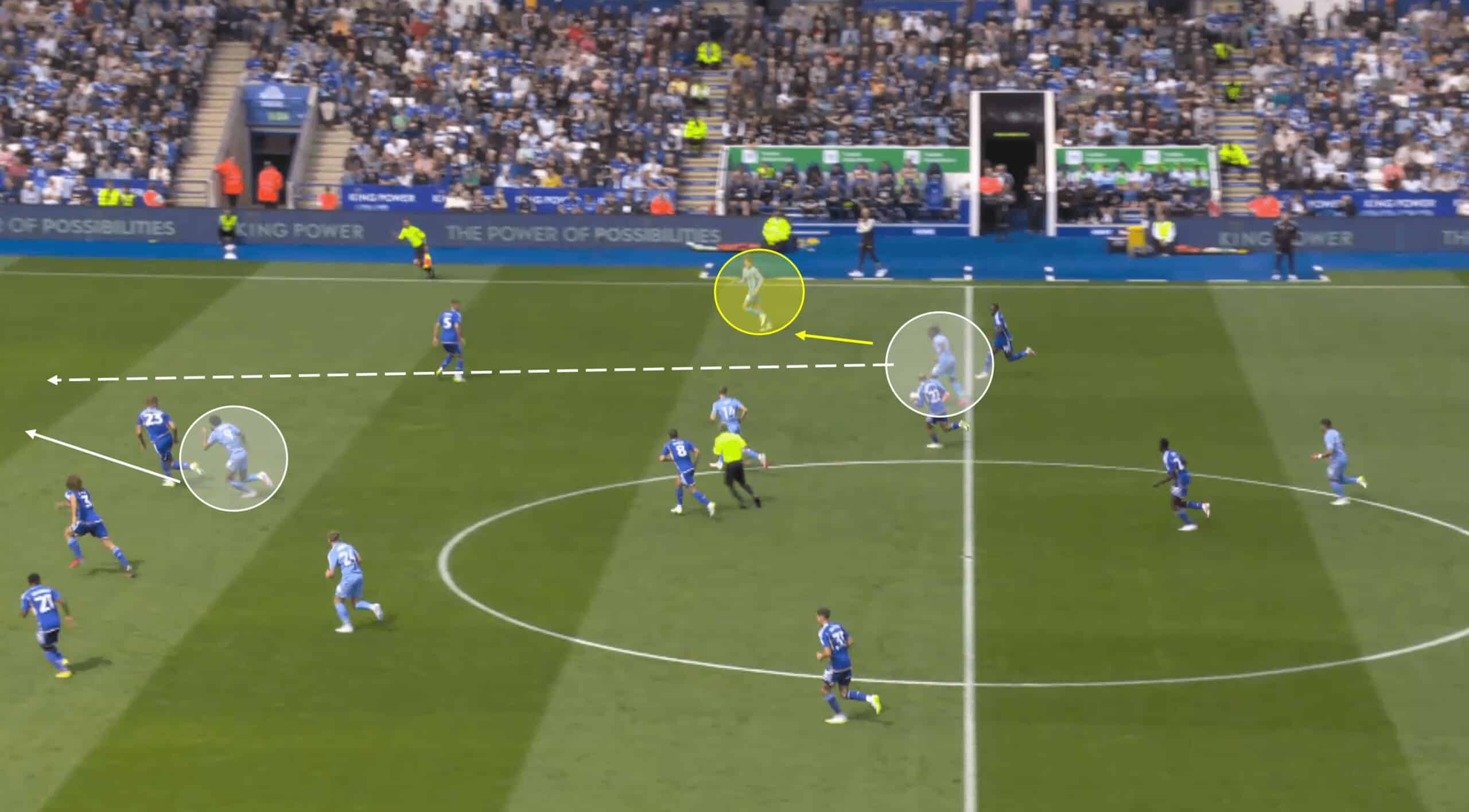




Comments